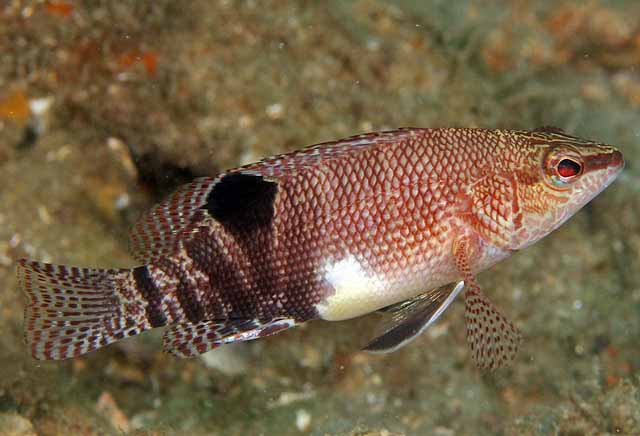Dr. Geoffrey Smith
NWFSC Biology Instructor
Previously, we highlighted one group of fishes within the seabass family (Serranidae) and this month we’ll be highlight another, whose genus is the namesake for the family. The Belted Sandfish Serranus subligarius is a relatively small fish, reaching a maximum size of about four inches. They are found in temperate to tropical waters of the western Atlantic from North Carolina down to Florida, throughout most of the Gulf of Mexico, and occasionally in some of the northern islands of the Caribbean (Figure 1), where they reside on hard bottom habitats, natural reefs, and artificial reefs. The Belted Sandfish is shades of brown to reddish brown with mottling and barring. There is a distinct dark brown band across the face and through the eye, a large white spot near the bottom, rear of the fish, and several black bands near the tail (Figure 2). Due to its small size, there is not typically directed harvest of this species for food, but they are occasionally harvested for the aquarium trade and are managed in Florida by FWC under the Marine Life (aquarium species) recreation regulations.
As with the groupers that were highlighted previously, one of the more interesting aspect of this species is how it reproduces. For a bit of review, the Mycteroperca were sequential protogynous hermaphrodites, mean that adult matured as females and at a particular size, age, or environmental condition transitioned into being a mature male. The Belted Sandfish, and most if not all other Serranus species, are what are known as simultaneous hermaphrodites. This means that a mature individual has functioning male and female reproductive structures. In theory, simultaneous hermaphrodites can be self-fertile (i.e., fertilize their own eggs), but this appears to be relatively rare among most species of simultaneous hermaphrodites and has only been documented in two species of vertebrates (two fish in the genus Kryptolebias). The Belted Sandfish spawns from late April through September in our region, and individuals can partake in up to three different mating roles in a single day. An individual can pair spawn as a male, where it courts another individual that is acting as a female. An individual can pair spawn as a female, where it is courted by an individual acting as a male (Figure 3). And an individual can act as a streaker male, that dart in on a pair of male-female spawners and releases its sperm. This species can be quite abundant in our nearshore waters, so keep your eye out for them if you happen to be diving or snorkeling near a jetty, reef, or wreck this summer.

Figure 1: Belted Sandfish distribution. Image from: https://biogeodb.stri.si.edu/caribbean/en/thefishes/species/3558

Figure 2: Typical coloration of a Belted Sandfish. Image from: https://biogeodb.stri.si.edu/caribbean/en/pages/random/10814 by Kevin Bryant

Figure 3: Mating pair of Belted Sandfish photographed at the Destin jetties. The darker individual is acting as a female and the lighter individual as a male in this particular encounter. Image from: https://www.flickr.com/photos/31486092@N05/8068252441 ©Dave C.



